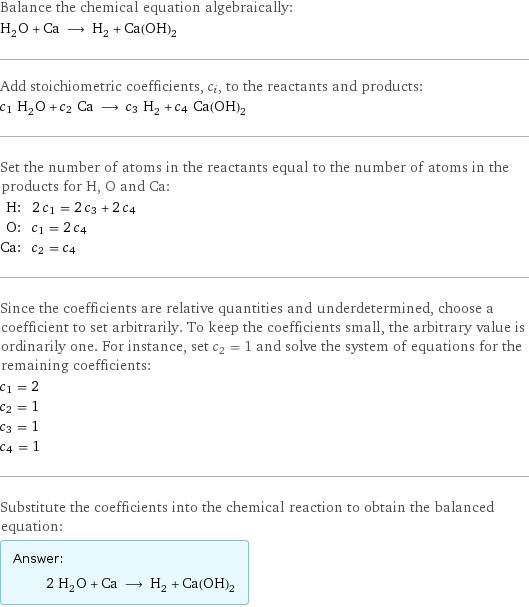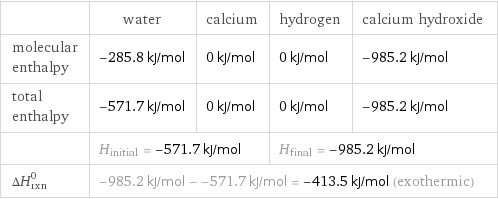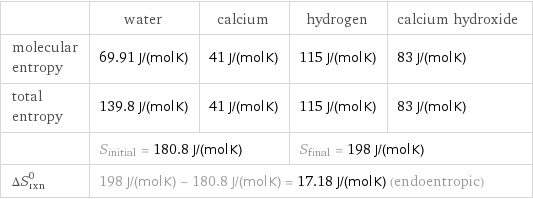Input interpretation

H_2O (water) + Ca (calcium) ⟶ H_2 (hydrogen) + Ca(OH)_2 (calcium hydroxide)
Balanced equation

Balance the chemical equation algebraically: H_2O + Ca ⟶ H_2 + Ca(OH)_2 Add stoichiometric coefficients, c_i, to the reactants and products: c_1 H_2O + c_2 Ca ⟶ c_3 H_2 + c_4 Ca(OH)_2 Set the number of atoms in the reactants equal to the number of atoms in the products for H, O and Ca: H: | 2 c_1 = 2 c_3 + 2 c_4 O: | c_1 = 2 c_4 Ca: | c_2 = c_4 Since the coefficients are relative quantities and underdetermined, choose a coefficient to set arbitrarily. To keep the coefficients small, the arbitrary value is ordinarily one. For instance, set c_2 = 1 and solve the system of equations for the remaining coefficients: c_1 = 2 c_2 = 1 c_3 = 1 c_4 = 1 Substitute the coefficients into the chemical reaction to obtain the balanced equation: Answer: | | 2 H_2O + Ca ⟶ H_2 + Ca(OH)_2
Structures

+ ⟶ +
Names

water + calcium ⟶ hydrogen + calcium hydroxide
Reaction thermodynamics
Enthalpy

| water | calcium | hydrogen | calcium hydroxide molecular enthalpy | -285.8 kJ/mol | 0 kJ/mol | 0 kJ/mol | -985.2 kJ/mol total enthalpy | -571.7 kJ/mol | 0 kJ/mol | 0 kJ/mol | -985.2 kJ/mol | H_initial = -571.7 kJ/mol | | H_final = -985.2 kJ/mol | ΔH_rxn^0 | -985.2 kJ/mol - -571.7 kJ/mol = -413.5 kJ/mol (exothermic) | | |
Entropy

| water | calcium | hydrogen | calcium hydroxide molecular entropy | 69.91 J/(mol K) | 41 J/(mol K) | 115 J/(mol K) | 83 J/(mol K) total entropy | 139.8 J/(mol K) | 41 J/(mol K) | 115 J/(mol K) | 83 J/(mol K) | S_initial = 180.8 J/(mol K) | | S_final = 198 J/(mol K) | ΔS_rxn^0 | 198 J/(mol K) - 180.8 J/(mol K) = 17.18 J/(mol K) (endoentropic) | | |
Equilibrium constant
![Construct the equilibrium constant, K, expression for: H_2O + Ca ⟶ H_2 + Ca(OH)_2 Plan: • Balance the chemical equation. • Determine the stoichiometric numbers. • Assemble the activity expression for each chemical species. • Use the activity expressions to build the equilibrium constant expression. Write the balanced chemical equation: 2 H_2O + Ca ⟶ H_2 + Ca(OH)_2 Assign stoichiometric numbers, ν_i, using the stoichiometric coefficients, c_i, from the balanced chemical equation in the following manner: ν_i = -c_i for reactants and ν_i = c_i for products: chemical species | c_i | ν_i H_2O | 2 | -2 Ca | 1 | -1 H_2 | 1 | 1 Ca(OH)_2 | 1 | 1 Assemble the activity expressions accounting for the state of matter and ν_i: chemical species | c_i | ν_i | activity expression H_2O | 2 | -2 | ([H2O])^(-2) Ca | 1 | -1 | ([Ca])^(-1) H_2 | 1 | 1 | [H2] Ca(OH)_2 | 1 | 1 | [Ca(OH)2] The equilibrium constant symbol in the concentration basis is: K_c Mulitply the activity expressions to arrive at the K_c expression: Answer: | | K_c = ([H2O])^(-2) ([Ca])^(-1) [H2] [Ca(OH)2] = ([H2] [Ca(OH)2])/(([H2O])^2 [Ca])](../image_source/c5fca1f43b0a963ba9900abfc1d37440.png)
Construct the equilibrium constant, K, expression for: H_2O + Ca ⟶ H_2 + Ca(OH)_2 Plan: • Balance the chemical equation. • Determine the stoichiometric numbers. • Assemble the activity expression for each chemical species. • Use the activity expressions to build the equilibrium constant expression. Write the balanced chemical equation: 2 H_2O + Ca ⟶ H_2 + Ca(OH)_2 Assign stoichiometric numbers, ν_i, using the stoichiometric coefficients, c_i, from the balanced chemical equation in the following manner: ν_i = -c_i for reactants and ν_i = c_i for products: chemical species | c_i | ν_i H_2O | 2 | -2 Ca | 1 | -1 H_2 | 1 | 1 Ca(OH)_2 | 1 | 1 Assemble the activity expressions accounting for the state of matter and ν_i: chemical species | c_i | ν_i | activity expression H_2O | 2 | -2 | ([H2O])^(-2) Ca | 1 | -1 | ([Ca])^(-1) H_2 | 1 | 1 | [H2] Ca(OH)_2 | 1 | 1 | [Ca(OH)2] The equilibrium constant symbol in the concentration basis is: K_c Mulitply the activity expressions to arrive at the K_c expression: Answer: | | K_c = ([H2O])^(-2) ([Ca])^(-1) [H2] [Ca(OH)2] = ([H2] [Ca(OH)2])/(([H2O])^2 [Ca])
Rate of reaction
![Construct the rate of reaction expression for: H_2O + Ca ⟶ H_2 + Ca(OH)_2 Plan: • Balance the chemical equation. • Determine the stoichiometric numbers. • Assemble the rate term for each chemical species. • Write the rate of reaction expression. Write the balanced chemical equation: 2 H_2O + Ca ⟶ H_2 + Ca(OH)_2 Assign stoichiometric numbers, ν_i, using the stoichiometric coefficients, c_i, from the balanced chemical equation in the following manner: ν_i = -c_i for reactants and ν_i = c_i for products: chemical species | c_i | ν_i H_2O | 2 | -2 Ca | 1 | -1 H_2 | 1 | 1 Ca(OH)_2 | 1 | 1 The rate term for each chemical species, B_i, is 1/ν_i(Δ[B_i])/(Δt) where [B_i] is the amount concentration and t is time: chemical species | c_i | ν_i | rate term H_2O | 2 | -2 | -1/2 (Δ[H2O])/(Δt) Ca | 1 | -1 | -(Δ[Ca])/(Δt) H_2 | 1 | 1 | (Δ[H2])/(Δt) Ca(OH)_2 | 1 | 1 | (Δ[Ca(OH)2])/(Δt) (for infinitesimal rate of change, replace Δ with d) Set the rate terms equal to each other to arrive at the rate expression: Answer: | | rate = -1/2 (Δ[H2O])/(Δt) = -(Δ[Ca])/(Δt) = (Δ[H2])/(Δt) = (Δ[Ca(OH)2])/(Δt) (assuming constant volume and no accumulation of intermediates or side products)](../image_source/d0ce634390dcc951232951e2df85cb57.png)
Construct the rate of reaction expression for: H_2O + Ca ⟶ H_2 + Ca(OH)_2 Plan: • Balance the chemical equation. • Determine the stoichiometric numbers. • Assemble the rate term for each chemical species. • Write the rate of reaction expression. Write the balanced chemical equation: 2 H_2O + Ca ⟶ H_2 + Ca(OH)_2 Assign stoichiometric numbers, ν_i, using the stoichiometric coefficients, c_i, from the balanced chemical equation in the following manner: ν_i = -c_i for reactants and ν_i = c_i for products: chemical species | c_i | ν_i H_2O | 2 | -2 Ca | 1 | -1 H_2 | 1 | 1 Ca(OH)_2 | 1 | 1 The rate term for each chemical species, B_i, is 1/ν_i(Δ[B_i])/(Δt) where [B_i] is the amount concentration and t is time: chemical species | c_i | ν_i | rate term H_2O | 2 | -2 | -1/2 (Δ[H2O])/(Δt) Ca | 1 | -1 | -(Δ[Ca])/(Δt) H_2 | 1 | 1 | (Δ[H2])/(Δt) Ca(OH)_2 | 1 | 1 | (Δ[Ca(OH)2])/(Δt) (for infinitesimal rate of change, replace Δ with d) Set the rate terms equal to each other to arrive at the rate expression: Answer: | | rate = -1/2 (Δ[H2O])/(Δt) = -(Δ[Ca])/(Δt) = (Δ[H2])/(Δt) = (Δ[Ca(OH)2])/(Δt) (assuming constant volume and no accumulation of intermediates or side products)